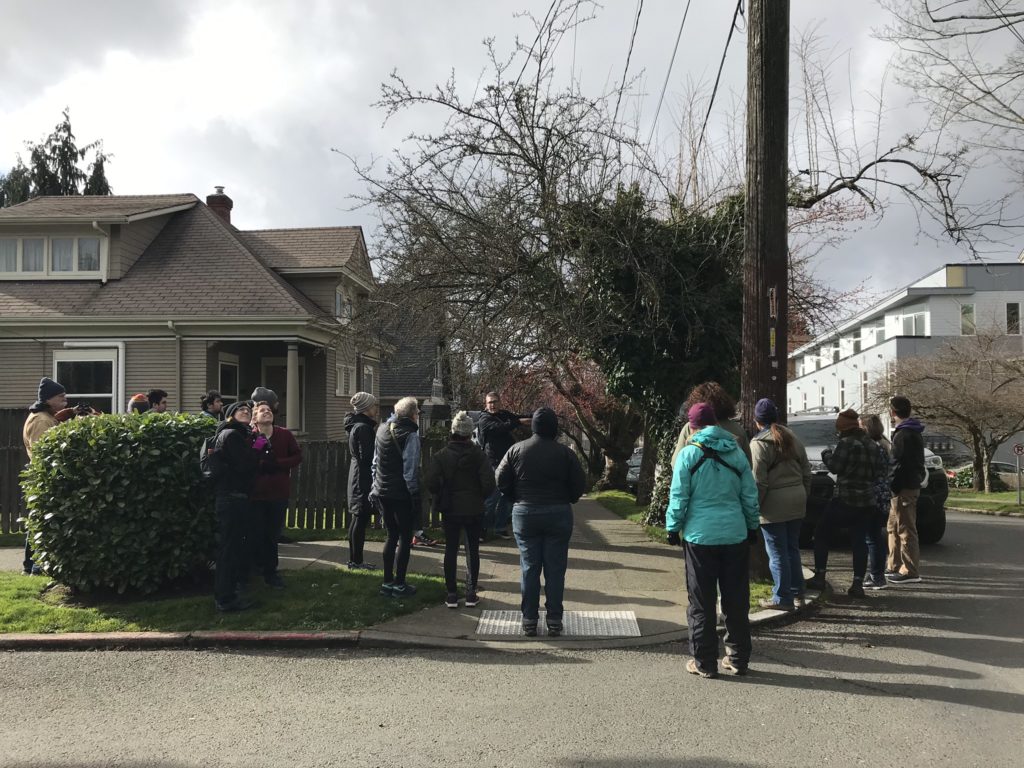We can’t live without them.
According to the United States Department of Agriculture, without pollinators the human race would not survive. Pollinators are a vital component of Earth’s ecosystems and consequently our food supply.
That’s why the Capitol Hill EcoDistrict has joined Seattle Audubon‘s Capitol Hill Connections program. The program is a collaboration among Seattle’s Urban Bird Treaty City partners to foster better conditions for pollinators, including birds, in the most densely populated urban village in the Pacific Northwest.
When the project began in October 2019, there were three main objectives: decrease pesticide use in Cal Anderson Park, engage the community in environmental stewardship, and enhance habitat for birds and pollinators along 11th Avenue East. You can sign up to receive emails and stay updated on the project here.
“This is part of our urban conservation work,” said Josh Morris, urban conservation manager at Seattle Audubon. “It’s very much associated with sustainability and getting urbanites connected with nature in their own backyard. Birds continue to provide a daily point of contact with wildlife that basically no other group of animals can do in urban areas. So they’re really accessible; they’re a really great hook for getting people interested in the natural world.”
The old adage ‘the early bird gets the worm’ is well-known for disparaging procrastination, but it also alludes to something important in the life cycle of many birds – they are predators. Their food sources sometimes have food sources of their own. The unlucky hawk or owl that preys upon rodents that have ingested rat poison may become poisoned itself. Birds whose diets rely upon insects are in a dire situation too. An overwhelming majority of land birds feed only insects to their young, and baby birds require an astounding volume of food. When humans introduce pesticides into their environments, insect populations are killed off and birds are left with a dearth of resources to support themselves and their young.
Restricting pesticide use is crucial to pollinators’ survival because of the simple fact that pesticides’ effects move up the food chain. However, pesticides aren’t the only challenge facing birds and other pollinators. Healthy habitat, especially along migration routes, is imperative.
“Migratory birds are traveling very, very long distances, sometimes 5,000 miles,” Josh said. “They are reliant upon continuous stretches of habitat along the entire way.”
In a neighborhood like Capitol Hill, the dense urban structure can lead to a lack of the lush environment birds require. Although there are parks and some green spaces, according to Josh, connectivity is key.
“Capitol Hill has some great habitat, but these patches are highly fragmented and discontinuous,” Josh said. “Connectivity of habitat is what helps facilitate the movement of birds across landscapes. That’s why we have to think about how to make sure it’s not just concrete between Seattle University and Cal Anderson Park, that birds can see trees that they can jump to and feel safe.”
Josh said there are several ways the community can help foster better conditions for birds and pollinators in general. He encourages community members to learn more about native plants, and if they are able, to plant them in their yards or put them on their balconies. He encourages gardeners to think about the types of resources, shelter, and habitat their plot of land might provide for birds and pollinators. Birds have a diversity of needs, so Josh encourages ‘messy gardening,’ which essentially involves less cleanup on the gardener’s part: leave trimmings and wilted fronds in the garden because they offer important foraging and shelter opportunities for birds.
The other two tips Josh has for helping out your neighborhood birds? Keep your cats indoors and mark your windows. Cats are expert predators, and no amount of bells around their neck can prevent the predatory behavior the average house cat is capable of. As for windows, birds often see trees or other habitat through large, unobstructed stretches of clear glass. Reflective glass that mirrors the image of the sky or leafy areas looks like an extension of habitat to birds, and they will attempt to fly through it. Putting up stickers, decals, or using stained glass can all be effective ways to show a bird ‘you can’t fly through this successfully.’ Josh recommends using the two-by-two rule: make sure there is no exposed glass that is larger than two inches by two inches.
“We are completely dependent on the services provided by pollinators,” Josh said. “It would be disastrous if we lost our pollinators, and there’s evidence that they’re under a lot of stress right now from pesticides and other sources.”
Although pollinator health remains a priority for the group, the project is also being slightly reshaped.
“Cal Anderson Park itself has become a focal point for different and more important types of conversation in my opinion,” Josh said. “So we’re thinking about how we can use this project to think about creating safe, welcoming spaces for everyone in the neighborhood while making room for very important conversations and supporting efforts for equity and justice.”

